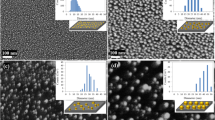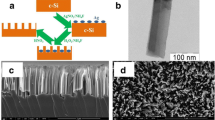Abstract
High-yield silicon nanowires (SiNWs) were produced on Si substrate by chemical vapor deposition (CVD) method and vapor-liquid-solid (VLS) technique with using SiH4 gas as a precursor. Au thin film with thicknesses of 20 nm deposited on Si (111) substrates were used as catalysts for the growth of nanowires. Field emission scanning electron microscopy (FESEM), Energy-dispersive X-ray (EDX), X-ray diffraction (XRD) and Transmission electron microscopy (TEM) were used to characterize the as-synthesized nanowires. The results showed that the SiNWs with uniform growth of nanowires in both directions of diameter and length have a crystalline structure. Increasing the temperature to 600 °C lead to the growth of compacted nanowires. Moreover, reflectance and J-V techniques were performed for optical and electrical measurements. SiNWs arrays surface has low reflectivity (<20%) in the entire spectral range of 400–1100 nm. Performance of two types of samples, namely sample with SiNWs on Si substrate and sample with only polished Si substrate have been compared. It was found that sample with SiNWs on Si substrate has the best optical and electrical properties, resulting suitable for photovoltaic devices.
Similar content being viewed by others
Data Availability
I confirm I have included a data availability statement in my main manuscript file.
References
Refino AD, Yulianto N, Syamsu I, Nugroho AP, Hawari NH, Syring A, Iskandar EKF, Voss T, Sumboja A, Peiner E, Wasisto HS (2021) Versatilely tuned vertical silicon nanowire arrays by cryogenic reactive ion etching as a lithium-ion battery anode. Sci Rep 11:19779
Pooria N, Daraee H, Eatemadi A (2016) Recent advances in silicon nanowire biosensors: synthesis methods, properties, and applications. Nanoscale Res Lett 11(1):406
Madosab E, Harpaka N, Levic G, Patolskya F, Peleda E, Golodnitsky D (2021) Synthesis and electrochemical performance of silicon-nanowire alloy anodes. RSC Adv 11:26586–26593
Nichkalo S, Druzhinin A, Evtukh A, Steblova O (2017) Silicon nanostructures produced by modified MacEtch method for antireflective Si surface. Nanoscale Res Lett 12(1):1–6
Min X, Fang M, Liu H, Liu Y, Wu X, Huang Z (2017) Growth, structure, and luminescence properties of novel silica nanowires and interconnected nanorings. Sci Rep 7(1):1–7
Moreels I (2020) Semiconductor nanostructures for electronic and Opto-electronic device applications. Phys Status Solidi A 217(5):200006
Bronstrup G, Jahr N, Leiterer C, Csáki A, Fritzsche W, Christiansen S (2010) Optical properties of individual silicon nanowires for photonic devices. ACS Nano 4(12):7113–7122
Jung JY, Guo Z, Jee SW, Um HD, Park KT, Lee JH (2010) A strong antireflective solar cell prepared by tapering silicon nanowires. Opt Express 18(103):A286–A292
Tarasov A, Wipf M, Bedner K, Kurz J, Fu W, Guzenko VA, Knopfmacher O, Stoop RL, Calame M, Schönenberger C (2012) True reference nanosensor realized with silicon nanowires. Langmuir 28(25):9899–9905
Zang JL, Zhao YP (2012) Silicon nanowire reinforced by single-walled carbon nanotube and its applications to anti-pulverization electrode in lithium ion battery. Compos Part B 43(1):76–82
Abiri H, Abdolahad M, Gharooni M, Hosseini SA, Janmaleki M, Azimi S, Hosseini M, Mohajerzadeh S (2015) Monitoring the spreading stage of lung cells by silicon nanowire electrical cell impedance sensor for cancer detection purposes. Biosens Bioelectron 68:577–585
Zabotnov SV, Skobelkina AV, Kashaev FV, Kolchin AV, Popov VV, Presnov DE, Sergeeva EA, Kirillin MY, Golovan LA (2020) Pulsed laser ablation of silicon nanowires in water and ethanol. Solid State Phenom 312:200–205
Rey M, Wendisch FJ, Goerlitzer ESA, Logoa, Tang JSJ, Bader RS, Bourret GR, Vogel N (2021) Anisotropic silicon nanowire arrays fabricated by colloidal lithography. Nanoscale Adv 3:3634–3642
Aziz DSA, Sakrani S, Jamaludin N (2021) Single step growth of vertically oriented zinc oxide nanowire using thermal evaporation. Defect Diffus Forum 411:25–36
Kolhep M, Zacharias M (2021) Low-temperature physical vapor deposition and electrical characterization of single-crystalline Zn nanowires. Cryst Growth Des 21:10
Young C, Wang J, Kim J, Sugahara Y, Henzie J, Yamauchi Y (2018) Controlled chemical vapor deposition for synthesis of nanowire arrays of metal–organic frameworks and their thermal conversion to carbon/metal oxide hybrid materials. Chem Mater 23(30):3379–3386
Hu JQ, Jiang Y, Meng XM, Lee CS, Lee ST (2003) A simple large-scale synthesis of very long aligned silica nanowires. Chem Phys Lett 367(3–4):339–343
Puglisi RA, Bongiorno C, Caccamo S, Fazio E, Mannino G, Neri F, Scalese S, Spucches D, Magna AL (2019) Chemical vapor deposition growth of silicon nanowires with diameter smaller than 5 nm. ACS Omega 4(19):17967–17971
Author information
Authors and Affiliations
Contributions
Not applicable.
Corresponding author
Ethics declarations
Ethics Approval
For this type of study formal consent is not required.
Consent to Participate
Informed consent was obtained from all individual participants included in the study.
Consent for Publication
The Authors hereby consents to publication of the Work in any and all Silicon publications.
Conflict of Interest
The authors declare that they have no conflict of interest.
Additional information
Publisher’s Note
Springer Nature remains neutral with regard to jurisdictional claims in published maps and institutional affiliations.
Rights and permissions
About this article
Cite this article
Hamidinezhad, H., Hayati, A. VLS Synthesis of Silicon Nanowires Array for Photovoltaic Devices. Silicon 14, 10257–10261 (2022). https://doi.org/10.1007/s12633-022-01739-y
Received:
Accepted:
Published:
Issue Date:
DOI: https://doi.org/10.1007/s12633-022-01739-y




